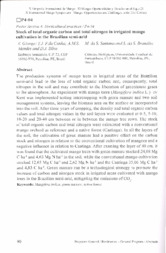Stock of total organic carbon and total nitrogen in irrigated mango cultivation in the Brazilian Semi-Arid.
Stock of total organic carbon and total nitrogen in irrigated mango cultivation in the Brazilian Semi-Arid.
Author(s): GIONGO, V.; CUNHA, T. J. F.; MENDES, A. M. S.; SILVA, D. J.; SANTANA, M. da S.; BRANDÃO, S. da S.
Summary: The production systems of mango trees in irrigated areas of the Brazilian semi-arid lead to the loss of total organie earbon and, eonsequently, total nitrogen in the soil and may ontribute to the liberation of greenhouse gases to the atmosphere. An experiment with mango trees (Mangifera indica L.) cv Kent was implemented testing intereropping with green manure and two soil management systems, leaving the biomass area on the surfaee or ineorporated into the soil. After three years of cropping, the density and total organie carbon values and total nitrogen values in the soil layers were evaluated at 0-5, 5-10, 10-20 and 20-40 em between or in between the mango tree rows. The stock of total organie earbon and total nitrogen were caleulated with a conventional mango orehard as reference and a native forest (Caatinga). In all the layers of the soil, the eultivation of green manure had a positive effeet on the carbon stock and nitrogen in relation to the conventional cultivation of mangoes and a negative influence in relation to Caatinga. After examing the layer of 40 em, it was found that the cultivated mango trees with green manure stoeked 24,08 Mg C ha' and 4,63 Mg N ha' in the soil, while the conventional mango eultivation stocked 12,65 Mg C ha' and 2,62 Mg N ha' and the Caatinga 35,06 Mg C ha' and 4,83 C ha'. Green manure ean be a teehnological strategy to promote the inerease of carbon and nitrogen stock in irrigated areas eultivated with mango trees in the Brazilian semi-arid, mitigating the emissions of CO2.
Publication year: 2013
Types of publication: Abstract in annals or event proceedings
Unit: Embrapa Semi-arid Region
Observation
Some of Embrapa's publications are published as ePub files. To read them, use or download one of the following free software options to your computer or mobile device. Android: Google Play Books; IOS: iBooks; Windows and Linux: Calibre.
Access other publications
Access the Agricultural Research Database (BDPA) to consult Embrapa's full library collection and records.
Visit Embrapa Bookstore to purchase books and other publications sold by Embrapa.

